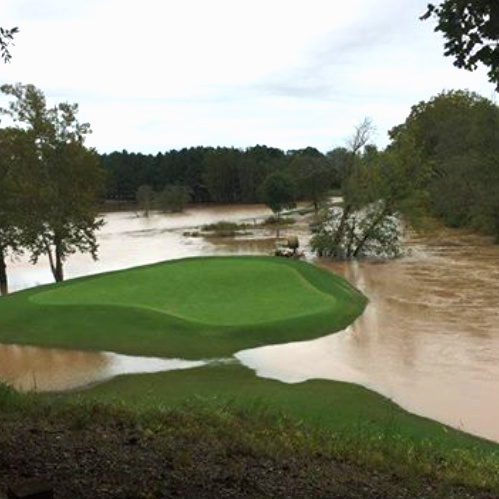
2015 was an extreme weather year for McConnell Golf. From flooding to below freezing temperatures, few of the 12 courses were immune from damage to greens and fairways.
Most McConnell properties are located in a natural transition weather zone. Therefore, courses utilize a mixture of warm and cool season grasses to ward against temperature fluctuation; yet neither grass type is able to thrive under some conditions. When that happens, the task is to recover swiftly, which is where Director of Agronomy Michael Shoun comes in.
DEEP FREEZE
January and February 2015 brought some of the coldest temperatures ever seen in North Carolina — some areas saw temperatures 30 degrees below average — and associated sleet, snow, and ice. Raleigh Country Club, Sedgefield Country Club, and Wakefield Plantation, all located in North Carolina’s Piedmont region, dealt with temperatures 30 degrees below average and snowfall between 7 and 9.5 inches.
That didn’t bode well for warm-season Bermuda grass. Those courses’ north-facing slopes, often lacking sunlight, suffered severe winter kill. Even if the greens thawed during the day, they inevitably refroze at night.
HUMID THAW
Already weakened from the winter, June brought sweltering heat to the Southeast, with 12 straight days of temperatures at or above 95 degrees in and around Raleigh. The extreme heat damaged the cool-season bentgrass greens on multiple courses, and was then followed by heavy rain during the late summer and early fall.
FLOODING
Torrential downpours led to flooding, and South Carolina’s record-breaking deluge made national headlines. Musgrove Mill Golf Club, located along the Enoree River, was an unfortunate victim. Over the fall, the course flooded four times. Some areas were submerged under 20 feet of water, secured riverbanks were destroyed, and a transfer pump used for delivering river water to an irrigation pond was entirely swept away.
SUCCESSES
But it wasn’t all havoc and recovery. Over the course of the year, the Dye course at Sedgefield Country Club was the one course to fully close for repair due to weather-related damages. “Once we realized we were going to have major issues at most of our courses due to weather, it was all hands on deck,” says Shoun. “Fortunately we had the financial support to get the winter-damaged sod cut out and immediately put new sod down and grow it in.” The team at Musgrove Mill worked from sunup to sundown for two weeks to clean up the course after the flood damage, and used an overseeding technique of putting down rye grass on top of Bermuda grass to make the greens playable during the winter until they could completely dry out the following spring.
During the eight-week closure of the Dye course at Sedgefield, the fairway damage was so extensive that the team had to essentially build a new golf course covering nearly 22 acres. The team used sprigs, small plant parts grown elsewhere then planted to create a playable turf. Sprigging is one of the only methods that can be used for destroyed grass.
THE FORECAST
As the year wrapped up with one of the warmest and wettest Decembers on record, it’s needless to say Shoun and his team hoped for an uneventful 2016. “One of the biggest drawbacks of this profession is that you can take every precaution you possibly can, and Mother Nature can still throw you a curve ball and change everything,” says Shoun. But for him, this is par for the course. “We just happen to be in a tough area but it definitely keeps things interesting. I wouldn’t have it any other way.”